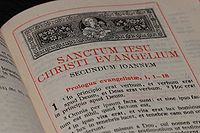- Sixto-Clementine Vulgate
-
Vulgata Sixto-Clementina, is the edition of Latin Vulgate from 1592, prepared by Pope Clement VIII. It was the second edition of the Vulgate authorised by this Pope, and it was used until the 20th century.
Contents
Clementine edition
The first Vulgate prepared by Pope Sixtus V was edited in 1590 but it was unsatisfactory from a textual point of view.[1] As a result this edition was short-lived.[2]
Clement VIII (1592–1605) ordered Franciscus Toletus, Augustinus Valerius, Fredericus Borromaeus, Robertus Bellarmino, Antonius Agellius, and Petrus Morinus to make corrections and to prepare a revision.[3] The revision was based on the Hentenian edition. It was printed on 9 November 1592, with a preface written by Cardinal Bellarmine. The misprints of this edition were partly eliminated in a second (1593) and a third (1598) edition.[4]The Clementine Vulgate contained in the Appendix additional apocryphal books: Prayer of Manasseh, 3 Esdras, and 4 Esdras.[5] It contained also Psalterium Gallicanum, as did the majority of the early editions of Vulgate.
It contains texts of the Acts 15:34[6] and the Comma Johanneum in 1 John 5:7.[7]
It was issued with the Bull, Cum Sacrorum (9 November 1592), which claimed that every subsequent edition must be assimillated to this one, no word of the text may be changed, nor even variant readings printed in the margin.[8]
It is cited in all critical editions and it is designated by siglum vgc or vgcl.[9]
Some differences to the Vulgata Sixtina
Vulgata Sixtina Vulgata Clementina Book of Genesis 18[10] 18,2 tabernaculi sui tabernaculi 18,2 in terra in terram 18,4 laventur pedes vestri lavate pedes vestros 18,5 confortetur confortate 18,5 loquutus locutus 18,2 Gomorrhaeorum Gomorrhae 18,28 quia propter Book of Exodus 11 11,14 constituit te te constituit 11,16 venerant venerunt 11,22 et eripuit eripuit 11,25 liberavit cognovit Reception
The Clementine edition differs from the Sixtine edition in about 3,000 places (according to Carlo Vercellone).[8] According to Bruce M. Metzger it differs in some 4,900 variants,[11] according to Kurt Aland in about 5,000 variants.[12]
The opportunity was too good for Protestants to miss, and Thomas James in his "Bellum Papale sive Concordia discors" (London, 1600), upbraids the two Popes on their high pretensions and palpable failure, possibly of both of them.[8] He gave a long list of the differences (about 2,000) between these two editions.[13] Translators of King James Version in the preface to the first edition from 1611 accused the pope of perversion of the Holy Scripture.[14]
The Clementine Vulgate was criticised by such textual critics as Richard Bentley, John Wordsworth, Henry Julian White, Samuel Berger, and P. Corssen.[15]
The Clementine Vulgate remained the official Latin Bible text of the Roman Catholic Church until the end of the 20th century, when the Nova Vulgata was issued. In 2001 the Congregation for Divine Worship and the Discipline of the Sacraments in Liturgiam authenticam announced that the Nova Vulgata is an official Bible of the Roman Catholic Church.[16]
References
- ^ Scrivener, Frederick Henry Ambrose; Edward Miller (1894). A Plain Introduction to the Criticism of the New Testament, vol. 2 (4 ed.). London: George Bell & Sons. p. 64.
- ^ Bruce M. Metzger, The Early Versions of the New Testament, Clarendon Press, Oxford 1977, p. 348.
- ^ Illustrations of Biblical Literature, vol. II, Rev. James Townley, DD. 1856
- ^ Bruce M. Metzger, The Early Versions of the New Testament, Clarendon Press, Oxford 1977, p. 349.
- ^ Praefatio, Biblia Sacra Vulgata, Deutsche Bibelgesellschaft, Stuttgart 1983, p. XX. ISBN 3-438-05303-9
- ^ UBS3, 478
- ^ Bruce M. Metzger, The Early Versions of the New Testament, Clarendon Press, Oxford 1977, p. 351.
- ^ a b c Scrivener, Frederick Henry Ambrose; Edward Miller (1894). A Plain Introduction to the Criticism of the New Testament, vol. 2 (4 ed.). London: George Bell & Sons. p. 65.
- ^ K. Aland (ed.), E. Nestle, (1991). Novum Testamentum Graece (ed. 26). Stuttgart: Deutsche Bibelgesellschaft. p. 19*. [NA26]
- ^ Quentin, Henri (1922). Mémoire sur l'établissement du texte de la Vulgate. Rome: Desclée. p. 195. http://www.archive.org/stream/mmoiresurlta01quenuoft#page/194/mode/2up. Retrieved 2011-01-23.
- ^ Metzger, Bruce M.; Bart D. Ehrman (2005). The Text of the New Testament: Its Transmission, Corruption, and Restoration. New York, Oxford: Oxford University Press. p. 78. ISBN 978-0-19-516122-9.
- ^ Aland, Kurt (1989). Der Text des Neuen Testaments. Stuttgart: Deutsche Bibelgesellschaft. p. 196. ISBN 3-438-06011-6.
- ^ Thomas James, A Treatise of the Corruptions of Scripture, Councils, and Fathers, by the Prelates, Pastors, and Fathers, p. 170.
- ^ The King James Bible, Translators Preface 1611 AD
- ^ Kenyon, F. G. (4th ed. 1939). Our Bible and the Ancient Manuscripts. London. p. 188. http://www.archive.org/stream/MN41613ucmf_0#page/n255/mode/2up. Retrieved 2011-01-23.
- ^ Liturgiam authenticam
Further reading
- Quentin, Henri (1922). Mémoire sur l'établissement du texte de la Vulgate. Rome: Desclée. pp. 192–208. http://www.archive.org/stream/mmoiresurlta01quenuoft#page/192/mode/2up. Retrieved 2011-01-23.
- Thomas James, A Treatise of the Corruptions of Scripture, Councils, and Fathers, by the Prelates, Pastors, and Fathers, p. 170 ff.
- Carlo Vercellone, Variae lectiones Vulgatae Latinae Bibliorum editionis, Romae 1860.
External links
- Vulgata Clementina – VulSearch & the Clementine Vulgate project
- Vulgata Clementina, with apocrypha, Leander van Ess Editore (1822-1824)
- New Testament (Clementine Vulgate & Rheims Version)
Categories:- 16th-century books
- Latin language
- History of Roman Catholicism
- 16th-century Christian texts
- Early printed Bibles
- Works by Jerome
Wikimedia Foundation. 2010.


